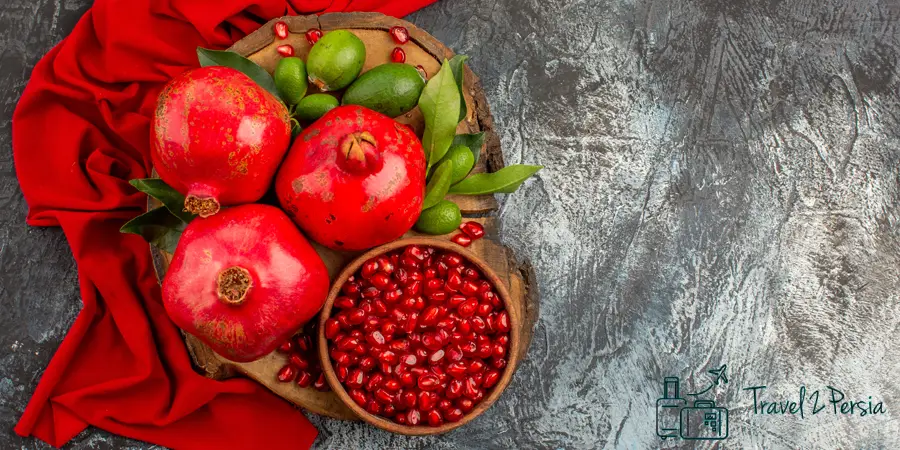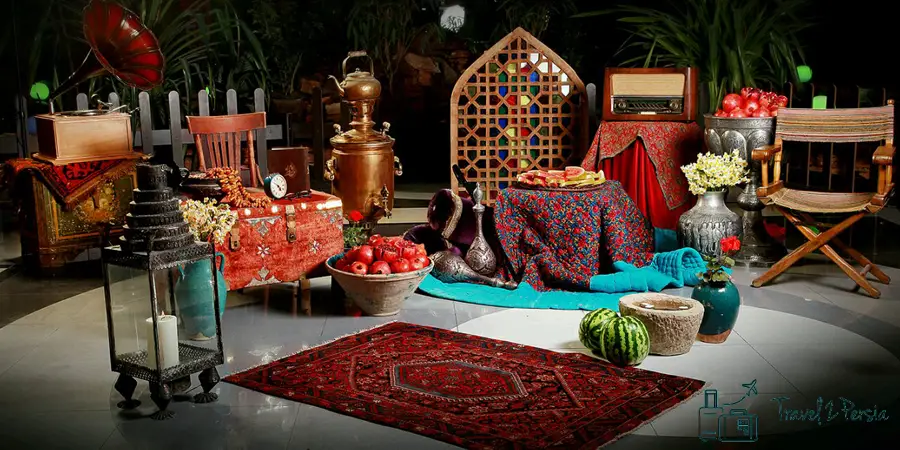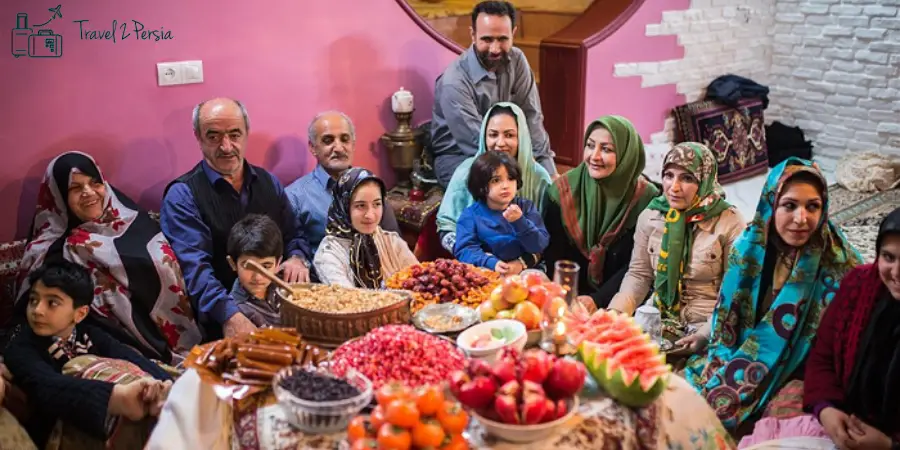Yalda Night, also known as Shab-e Yalda, is an ancient Iranian celebration that marks the longest night of the year, usually falling on or around December 21st. The word “Yalda” means “birth” and refers to the birth of Mithra, the ancient Persian sun god. in this article we want to talk more about yalda night so stay with us.
yalda night history
This celebration has its roots in Zoroastrianism, the ancient pre-Islamic religion of Persia. Yalda Night is a time for family and friends to gather together to ward off the darkness of the long winter night. The festival is a symbol of the triumph of light and goodness over darkness and evil.
One of the traditional customs of Yalda is the consumption of specific foods and fruits, especially watermelon and pomegranates. These fruits are believed to symbolize the colors of dawn and the glow of life. Other customary activities include storytelling, poetry recitation, and the reading of Hafez, a renowned Persian poet, to seek insights into the future.
Yalda Night is an occasion when people stay up late into the night, engaging in cheerful conversations, enjoying special foods, and celebrating the turning point when the days start to lengthen again. Over the centuries, this celebration has become an integral part of Iranian culture and is observed by Iranians around the world, regardless of their religious beliefs. It reflects the deep cultural and historical ties of the Iranian people to the changing seasons and the eternal struggle between light and darkness.
yalda meaning in farsi
In Farsi, the word “Yalda” (شب یلدا) refers to the celebration of the winter solstice, specifically the longest night of the year. The term itself is of Syriac origin and is related to the word “yaldā,” meaning birth. In the context of the celebration, it symbolizes the birth of the sun or the victory of light over darkness. Iranians celebrate Yalda Night to welcome the gradual return of longer days and shorter nights, signaling the end of winter and the coming of spring. The celebration has deep cultural and historical roots in Iran, connecting people to ancient traditions and the natural cycle of the seasons.

how is yalda celebrated?
Yalda Night is celebrated in various ways, typically involving family and friends gathering together. Here are some common customs and activities associated with the celebration:
- Family and Friends Gathering:
- Yalda Night is primarily a time for family and friends to come together.
- People often gather in the homes of elders or those with larger spaces to accommodate the festivities.
- Special Foods:
- Consumption of specific foods is an essential part of the celebration.
- Fruits such as watermelon and pomegranates are commonly enjoyed as they are believed to symbolize the colors of dawn and the glow of life.
- Reading Poetry:
- Poetry plays a significant role.
- People often read poetry, particularly the works of Hafez, a revered Persian poet.
- Some engage in divination practices by randomly opening Hafez’s poetry book and interpreting the poem as a guide for the upcoming year.
- Storytelling:
- Storytelling is a traditional activity.
- Elders might share folklore, myths, or family stories to pass on cultural and historical knowledge.
- Staying Awake:
- Yalda Night is the longest night of the year, and staying awake through the night is customary.
- The idea is to celebrate the triumph of light over darkness.
- Candle Lighting:
- Lighting candles or a bonfire is another tradition, symbolizing the defeat of darkness and the victory of light.
- Gift-Giving:
- Giving and receiving gifts is a common practice during Yalda Night, especially among family members and close friends.
- Music and Entertainment:
- Music and other forms of entertainment, such as playing traditional games, are often part of the celebration.

yalda night symbols
Yalda is rich in symbolism, reflecting ancient Persian beliefs and traditions associated with the winter solstice. Here are some key symbols :
- Pomegranates:
- Pomegranates are a prominent symbol of Yalda Night. Their vibrant red color represents the glow of life and the sun. Breaking open a pomegranate is believed to bring blessings and good fortune for the coming year.
- Watermelon:
- Watermelon, with its green rind and red interior, symbolizes the colors of dawn. It is often shared and enjoyed.
- Candles and Bonfires:
- Lighting candles or a bonfire represents the triumph of light over darkness. The flames are symbolic of the sun’s return and the defeat of the longest night of the year.
- Hafez’s Divan (Poetry Book):
- The poetry of Hafez, a revered Persian poet, is central to Yalda Night. People often turn to his Divan (collection of poems) and seek guidance or insights for the upcoming year by randomly opening the book and interpreting the poem on that page.
- Fruits and Nuts:
- Beyond pomegranates and watermelons, other fruits and nuts are often part of the Night spread. These symbolize the abundance of nature and the hope for a fruitful year ahead.
- Nightly Vigil:
- Staying awake throughout the night is a symbolic act representing the endurance of darkness and the anticipation of the return of longer days.
- Divination Practices:
- Engaging in divination practices, such as reading poetry or interpreting symbols and dreams, is common during Night. It adds a mystical and introspective element to the celebration.
- Family and Togetherness:
- The gathering of family and friends is a fundamental symbol of Yalda Night. It represents the warmth of human connections and the support of loved ones during the cold winter months.
- Gifts:
- Exchanging gifts is a way of expressing love and good wishes for the new year. It symbolizes the sharing of blessings and the importance of generosity.
- Traditional Clothing:
- Wearing traditional clothing, such as Persian attire, is a way of connecting with cultural roots and emphasizing the significance of the occasion.

yalda night traditions
Yalda is marked by various traditions that have been passed down through generations, reflecting the cultural and historical significance of the celebration. Here are some common Yalda Night traditions:
- Family Gatherings:
- Yalda Night is a time for families to come together. Elders often host gatherings in their homes, and extended family and friends join in the celebration.
- Special Foods:
- Consuming specific foods is an integral part of Yalda. Fruits such as watermelon and pomegranates, as well as nuts and sweets, are commonly enjoyed.
- Reading Poetry:
- The poetry of Hafez, a renowned Persian poet, is a central element of Yalda Night. Families gather to read Hafez’s poems, and some engage in the tradition of Fal-e Hafez, where they randomly open Hafez’s Divan (collection of poems) to seek insights or guidance for the coming year.
- Candle Lighting and Bonfires:
- Lighting candles or a bonfire is symbolic of the triumph of light over darkness. This practice is often accompanied by prayers or wishes for the well-being of family members.
- Staying Awake:
- It is customary to stay awake throughout the night of Yalda, emphasizing the victory of light as the longest night comes to an end.
- Storytelling:
- Elders often share traditional stories, myths, and folklore with younger generations. This helps pass on cultural and historical knowledge, reinforcing a sense of identity.
- Divination Practices:
- Yalda Night is seen as a spiritually significant time, and some people engage in divination practices to gain insights into the future. This may include reading poetry, interpreting dreams, or other symbolic activities.
- Gift-Giving:
- Exchanging gifts is a common tradition. It symbolizes love, goodwill, and the sharing of blessings with one another.
- Wearing New Clothes:
- Wearing new or special clothes for Yalda is a tradition that signifies the importance of the occasion. It is a way of showing respect for the celebration.
- Music and Entertainment:
- Music, traditional dances, and other forms of entertainment are often part of celebrations, adding to the festive atmosphere.
- Charitable Acts:
- Some families engage in charitable acts during Night, emphasizing the importance of generosity and helping those in need, especially during the winter season.
These traditions vary among families and regions, but they collectively contribute to the festive and meaningful atmosphere of Yalda Night, fostering a sense of connection with Iranian cultural heritage and the natural cycles of the seasons.
what to eat on yalda night?
- Pomegranates:
- Pomegranates are a quintessential part of Yalda Night. Their vibrant red color symbolizes the glow of life and the sun. Breaking open a pomegranate is believed to bring blessings and good fortune for the coming year.
- Watermelon:
- Watermelon, with its green rind and red flesh, represents the colors of dawn. It is often shared and enjoyed during Yalda Night gatherings.
- Nuts and Dried Fruits:
- Assorted nuts, such as almonds, walnuts, and hazelnuts, along with dried fruits, are commonly served. These snacks symbolize the abundance of nature and the hope for a fruitful year ahead.
- Ajil (Mixed Nuts and Seeds):
- Ajil is a mixture of various nuts and seeds, often including pistachios, almonds, walnuts, pumpkin seeds, and dried fruits. It is a popular snack during Yalda Night.
- Halva:
- Halva, a sweet confection made from sesame paste or flour, is enjoyed as a dessert. It adds sweetness to the celebration.
- Yalda Soup:
- Some families prepare a special soup for Yalda Night, often a hearty and warming soup with a variety of grains and legumes.
- Aash-e Reshteh:
- Aash-e Reshteh is a traditional Iranian noodle soup that is often prepared for special occasions. It typically includes herbs, legumes, and sometimes meat.
- Sohan Asali:
- Sohan Asali is a traditional Iranian honey and saffron brittle. It’s a sweet treat that adds a touch of luxury to the festive spread.
- Shirini (Sweets):
- Various Persian sweets and pastries, such as baklava, zoolbia, and bamieh, might be included in the Yalda Night menu for those with a sweet tooth.
- Tea and Herbal Infusions:
- Serving tea, especially Persian tea, along with herbal infusions is a common practice. Warm beverages contribute to the cozy atmosphere of the celebration.
Remember that the specific foods served during Yalda Night can vary among families and regions. The emphasis is on enjoying a festive and communal meal that symbolizes the turning point from the longest night toward the increasing daylight of the coming year.




No comment